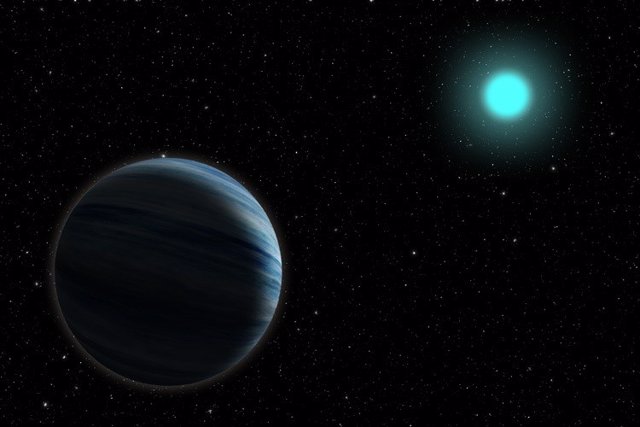Artist’s concept of a Neptune-sized planet, left, around a blue A-type star. – STEVEN GIACALONE, UC BERKELEY
Aug. 12 () –
Berkeley astronomers have observed that the brightest stars in the night sky they can strip Neptune-sized planets of their rocky cores.
It is the conclusion of a rare find, a ‘hot Neptune’ around a bright blue star, which offers clues to the scarcity of hot Neptunes.
Over the past 25 years, astronomers have found thousands of exoplanets around stars in our galaxy, but more than 99% of them orbit smaller stars, from red dwarfs to stars. slightly more massive than our sun, which is considered an average-sized star.
Few have been discovered around even more massive stars, such as A-type stars, bright blue stars twice the size of the sun, and most of the exoplanets that have been observed are Jupiter-sized or larger. Some of the brightest stars in the night sky, such as Sirius and Vega, are A-type stars.
UC Berkeley astronomers now report a new Neptune-sized planet, called HD 56414 b, around a hot-burning but short-lived A-type star. they provide a clue as to why so few gas giants smaller than Jupiter have been seen around the brightest 1% of stars in our galaxy.
Current exoplanet detection methods more easily find planets with short, fast orbital periods around their stars, but this newly discovered planet has a longer orbital period than most discovered to date. The researchers suggest that an easier-to-find Neptune-sized planet located closer to a bright A-type star would be rapidly stripped of its gas by strong stellar radiation and reduced to an undetectable core.
While this theory has been proposed to explain Neptune’s so-called hot deserts around redder stars, it was unknown whether this extended to hotter stars (A-type stars are 1.5 to 2 times hotter than the Sun). ) due to the scarcity of known planets around some of the brightest stars in the galaxy.
“It’s one of the smallest planets we know of around these really massive stars,” he said. it’s a statement Steven Giacalone, UC Berkeley graduate student. “In fact, this is the hottest star we know with a planet smaller than Jupiter. This planet is interesting first of all because these kinds of planets are really hard to find, and we probably won’t find many like them in the foreseeable future.”
The discovery of what researchers call a “hot Neptune” just outside the zone where the planet would have been stripped of its gas suggests that bright A-type stars may have numerous invisible cores within Neptune’s hot zone. waiting to be discovered through more sensitive techniques.
“We might expect to see an accumulation of remnant Neptunian nuclei in short orbital periods” around such stars, the researchers concluded in their paper.
The discovery also adds to our understanding of how planetary atmospheres evolve, said Courtney Dressing, an assistant professor of astronomy at UC Berkeley.
“There’s a big question about how planets retain their atmospheres over time,” said Dressing. “When we look at smaller planets, are we looking at the atmosphere that it formed with when it originally formed from an accretion disk? Are we looking at an atmosphere that was outgassed from the planet over time? If we are able to see planets that they receive different amounts of light from their star, especially different wavelengths of light, which is what A stars allow us to do, it allows us to change the ratio of X-rays to ultraviolet light, then we can try to see exactly how a planet maintains its atmosphere over time.”
Giacalone and Dressing reported their discovery in a paper accepted by The Astrophysical Journal Letters and published online.
According to Dressing, it is well established that highly irradiated Neptune-sized planets orbiting less massive Sun-like stars are rarer than expected. But it is not known whether this is true for planets orbiting A-type stars because those planets are difficult to detect.
And an A-type star is a different animal from the smaller F, G, K, and M dwarfs. Nearby planets orbiting Sun-like stars receive large amounts of X-rays and ultraviolet radiation, but nearby planets orbiting Sun-like stars type A they experience much more near ultraviolet radiation than x-ray radiation or extreme ultraviolet radiation.
“Determining whether Neptune’s hot desert also extends to A-type stars provides insight into the importance of near-ultraviolet radiation in controlling atmospheric escape,” he said. “This result is important for understanding the physics of atmospheric mass loss and investigating the formation and evolution of small planets.”
The planet HD 56414 b was detected by NASA’s TESS mission as it transited its star, HD 56414. Dressing, Giacalone, and their colleagues confirmed that HD 56414 was an A-type star by obtaining spectra with the 1.5-meter telescope. operated by the Small and Moderate Aperture Research Telescopic System (SMARTS) Consortium at Cerro Tololo in Chile.
The planet has a radius 3.7 times that of Earth and orbits the star every 29 days at a distance equivalent to about a quarter of the distance between Earth and the sun. The system is about 420 million years old, much younger than our sun’s 4.5 billion year old.















Add Comment